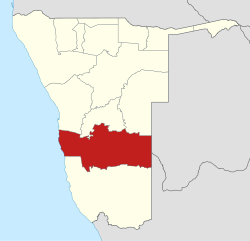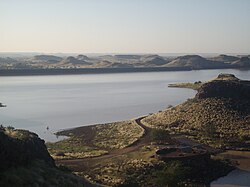Hardap Region
Hardap Region | |
|---|---|
 Location of the Hardap Region inNamibia | |
| Country | Namibia |
| Capital | Mariental |
| Government | |
| • Governor | Salomon April[1] |
| Area | |
| • Total | 109,781 km2(42,387 sq mi) |
| Population | |
| • Total | 106,680 |
| • Density | 0.97/km2(2.5/sq mi) |
| Time zone | UTC+2(CAT) |
| HDI(2017) | 0.665[5] medium·5th |
| Website | hardaprc |
Hardapis one of the fourteenregions of Namibia,its capital isMariental.Hardap contains the municipality of Mariental, the townsRehobothandAranos,and the self-governed villagesGibeon,Gochas,Kalkrand,StamprietandMaltahöhe.It is home to theHardap Dam.
Geography
[edit]Hardap stretches the entire width of Namibia, from theAtlantic Oceanin the west to Namibia's eastern national border. In the northeast, it borders theKgalagadi DistrictofBotswana,and in the southeast, it borders theNorthern CapeProvince ofSouth Africa.Domestically, it borders the following regions:
Politics
[edit]As of 2020, Hardap had 52,534 registered voters.[6]The region comprises eightelectoral constituencies:
- Gibeon
- Mariental Rural
- Mariental Urban
- Rehoboth Rural
- Rehoboth Urban East
- Rehoboth Urban West
- Aranos(created in 2013)
- Daweb(created in 2013)
As in all other regions,SWAPOwas by far the strongest political party sinceNamibian independence.In February 2009, then-governor Hanse-Himarwa was condemned by theNational Society for Human Rightsof Namibia for declaring Hardap Region "SWAPO territory" and urging supporters not to allow other political parties to "invade" the region.[7]
Presidential elections
[edit]In the2004 presidential election,the region supportedHifikepunye PohambaofSWAPOwith a narrow absolute majority of the votes (52%), following byBen UlengaofCongress of Democrats(21%) andKatuutire Kauraof theDemocratic Turnhalle Alliance(16%). Four other candidates combined for the 11%.[8]
Regional elections
[edit]In the2004 regional electionfor theNational Assembly of Namibia,SWAPO won all six constituencies.[9]
In the2015 regional electionsSWAPO obtained 65% of the total votes (2010:60%)[6]and won seven of the eight constituencies with only Rehoboth Urban West narrowly won by the opposition.[10][11]In the2020 regional electiontheLandless People's Movement(LPM, an opposition party formed in 2016) was the strongest party. It obtained 45% of votes overall and won seven of the eight constituencies.[6]
Governors
[edit]- Katrina Hanse-Himarwa(2004–2015)[12]
- Esme Sophia Isaack(2015–2020)[13]
- Salomon April(2020–present)[1]
Economy and infrastructure
[edit]Hardap has 55 schools with a total of 21,886 pupils. The region has good infrastructure with well-developed road networks.[14]
Demographics
[edit]
According to the Namibia 2001 Population and Housing Census, Hardap had a population of 68,249 (33,665 females and 34,579 males or 103 males for every 100 females) growing at an annual rate of 0.3%. Thefertility ratewas 3.6 children per woman. 46% lived in urban areas while 54% lived in rural areas, and with an area of 109,651 km2,the population density was 0.6 persons per km2.By age, 13% of the population was under 5 years old, 23% between 5 and 14 years, 55% between 15 and 59 years, and 8% 60 years and older. The population was divided into 15,039 households, with an average size of 4.4 persons. 34% of households had a female head of house, while 66% had a male. For those 15 years and older, 54% had never married, 30% married with certificate, 1% married traditionally, 9% married consensually, 2% were divorced or separated, and 4% were widowed.[15]
The most commonly spoken languages at home wereAfrikaans(44% of households), andNama/Damara(44%). For those 15 years and older, the literacy rate was 83%. Nearly half of the population are from coloured and white Namibian groups. In terms of education, 84% of girls and 83% of boys between the ages of 6–15 were attending school, and of those older than 15, 73% had left school, 9% were currently at school, and 13% had never attended.[15]
In 2001 the employment rate for the labor force (64% of those 15+) was 66% employed and 34% unemployed. For those 15+ years old and not in the labor force (29%), 29% were students, 37% home-makers, and 33% retired, too old, etc.[15]According to the 2012 Namibia Labour Force Survey, unemployment in the Hardap Region stood at 28.8%. The two studies are methodologically not comparable.[16]
Among households, 95% hadsafe water,34% no toilet facility, 51% electricity for lighting, 77% access toradio,and 20% had wood or charcoal for cooking. In terms of household's main sources of income, 9% derived it from farming, 61% from wages and salaries, 7% cash remittances, 5% from business or non-farming, and 15% from pension.[15]
For every 1000 live births there were 62 female infant deaths and 64 male. The life expectancy at birth was 53 years for females and 51 for males. Among children younger than 15, 4% had lost a mother, 6% a father, and 1% were orphaned by both parents. 6% of the entire population had a disability, of which 19% were deaf, 47% blind, 7% had a speech disability, 10% hand disability, 28% leg disability, and 6% mental disability.[15]
External links
[edit]References
[edit]Notes
[edit]- ^ab"Goodbye".Namibian Sun.10 April 2020. p. 1.
- ^"Namibia's Population by Region".Election Watch(1). Institute for Public Policy Research: 3. 2013.
- ^"Hardap 2011 Census Regional Profile"(PDF).Statistics Namibia.Retrieved10 April2020.[permanent dead link]
- ^"2023 Population & Housing Census Preliminary Report"(PDF).Statistics Namibia.Archived fromthe original(PDF)on 2024-03-24.Retrieved2024-03-16.
- ^"Sub-national HDI - Area Database - Global Data Lab".hdi.globaldatalab.org.Retrieved2018-09-13.
- ^abc"Regional Council 2020 Election Results".Interactive map.Electoral Commission of Namibia.18 January 2021. Archived fromthe originalon 12 June 2021.Retrieved19 March2021.
- ^"Hardap Governor Incites Violence".Windhoek, Namibia: NamRights (National Society for Human Rights (Namibia)). 22 February 2009. Archived fromthe originalon 22 July 2011.Retrieved9 November2009.
- ^"Hardap Region 2004 President results".Election Watch Namibia. Archived fromthe originalon 22 July 2011.
- ^"Electoral Act, 1992: Notification of Result of General Election for Regional Councils"(PDF).Government Gazette of the Republic of Namibia.No. 3366.Government of Namibia.3 January 2005. p. 15.
- ^"Regional Council Election Results 2015".Electoral Commission of Namibia.3 December 2015. pp. 2–3. Archived fromthe originalon 8 December 2015.Retrieved21 December2015.
- ^Menges, Werner (29 November 2015)."Mixed results for opposition in regional polls".The Namibian.
- ^"Hanse-Himarwa, Katrina".Government of Namibia.Retrieved2 February2016.
- ^"President announces governors".The Namibian.10 April 2015. Archived fromthe originalon 14 April 2015.Retrieved14 April2015.
- ^Miyanicwe, Clemans; Kahiurika, Ndanki (27 November 2013). "School counsellors overstretched".The Namibian.p. 1.
- ^abcde"Hardap Region – Census Indicators, 2001".National Planning Commission. 2001. Archived fromthe originalon 2012-01-11.Retrieved2008-12-27.
- ^Duddy, Jo Maré (11 April 2013)."Unemployment rate still alarmingly high".The Namibian.Archived fromthe originalon 14 April 2013.
